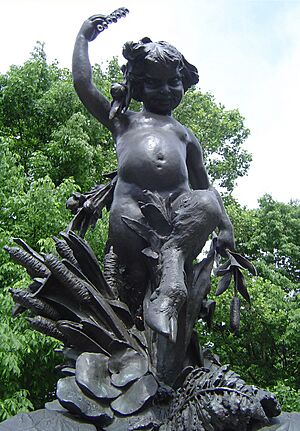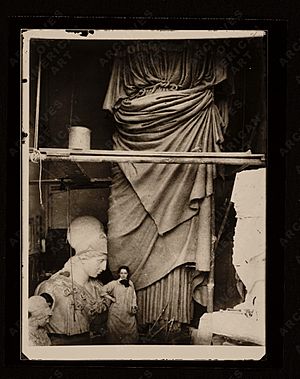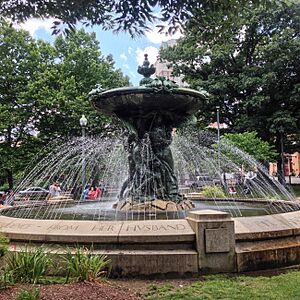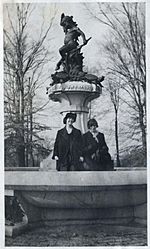Enid Yandell facts for kids
Quick facts for kids
Enid Yandell
|
|
|---|---|
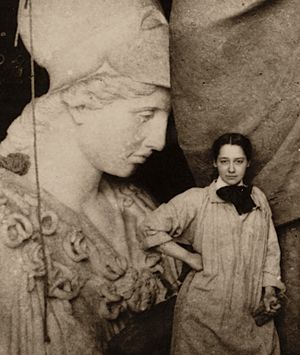
Enid Yandell with her sculpture of Pallas Athena, 1896
|
|
| Born | October 6, 1869 Louisville, Kentucky, U.S.
|
| Died | June 12, 1934 (aged 64) Boston, Massachusetts, U.S.
|
| Resting place | Cave Hill Cemetery Louisville, Kentucky, U.S. |
Enid Yandell (born October 6, 1869 – died June 12, 1934) was an American sculptor. She came from Louisville, Kentucky. Enid learned from famous artists like Auguste Rodin in Paris, Philip Martiny in New York City, and Frederick William MacMonnies.
Enid was known for making sculptures of people's heads (called portrait busts) and large public statues. She also created many garden pieces and smaller artworks. The Speed Art Museum in her hometown has a large collection of her plaster sculptures. She helped design The Woman's Building at the Chicago World's Fair.
Contents
Becoming an Artist
Enid Yandell was the oldest daughter of Dr. Lunsford Pitts Yandell Jr. and Louise Elliston Yandell. They lived in Louisville, Kentucky. Enid studied chemistry and art at Hampton College, a school for girls in Louisville.
She then went to the Art Academy of Cincinnati. She finished a four-year program in just two years! She won a first-prize medal when she graduated in 1889. Enid also learned from well-known sculptors like Lorado Taft, Philip Martiny, and Karl Bitter.
The White Rabbits
Enid Yandell was part of a group of women sculptors called the White Rabbits. Sculptor Lorado Taft brought them together. Their job was to create many statues and decorations for the Horticultural Building. This was for the World's Columbian Exposition in Chicago in 1893.
Enid also designed a caryatid (a sculpted female figure used as a column) for the roof garden of The Woman's Building. She even co-wrote a book about her experiences planning the fair. It was called Three Girls in a Flat (1892).
Studying in Paris
In 1894, Enid Yandell traveled to Paris, France. She studied with Frederick William MacMonnies and other teachers. She also worked with the famous sculptor Auguste Rodin. Enid often returned to Paris. She had a studio there and showed her art at the Paris Salon.
In 1898, Yandell became the first woman to join the National Sculpture Society. She passed away on June 12, 1934, in Boston, Massachusetts. She is buried in Cave Hill Cemetery in Louisville, Kentucky.
Famous Sculptures
Daniel Boone Statue
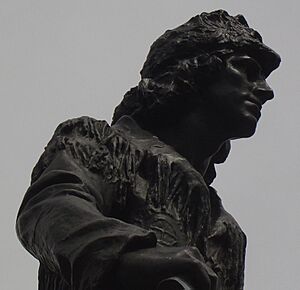
One of Yandell's sculptures is a nine-foot tall statue of Daniel Boone. The Filson Club of Louisville asked her to create it. Enid first made a plaster model. This model was shown at several art shows.
Later, in 1906, the sculpture was finally made into bronze for the city of Louisville. The Daniel Boone statue survived a big tornado outbreak in 1974. It is now in Cherokee Park, Louisville, Kentucky. Another copy of the statue was made in 1967. It is located at Eastern Kentucky University in Richmond, Kentucky.
Pallas Athena for Nashville
When she was 27, Enid Yandell was asked to create a huge sculpture of Pallas Athena. This was for the 1897 Tennessee Centennial and International Exposition in Nashville. Nashville is known as "The Athens of the South," so a Greek sculpture fit perfectly.
Yandell made the statue in her Paris studio. She based her design on an ancient Greek statue found in Italy. It showed Athena with one arm raised in victory and the other open in welcome. The 40-foot sculpture was shipped to Nashville in many pieces. It was put together there and stood in front of the Fine Arts Building. This building was a full-size copy of the Parthenon in Athens, Greece.
Like other statues at the exhibition, Yandell's Athena was made from a temporary material called "staff." It was never made into bronze. Within a year, the sculpture fell apart. The Nashville Parthenon was later rebuilt with strong, lasting materials. It still stands today. A different Athena statue was unveiled inside the Nashville Parthenon in 1990.
The Wheelmen's Bench

The Wheelmen's Bench is another important sculpture by Enid Yandell. It is also in Louisville, Kentucky. It sits where Third Street and Southern Parkway meet. This sculpture was part of a special event in the 1890s. It celebrated a new bicycle path from downtown Louisville to Iroquois Park.
A sign at the site once said:
- Erected in 1897 by the Kentucky Division of the League of American Wheelmen.
- It honored cycling pioneer A. D. Ruff (1827–96).
- He was the League's oldest member and had bicycled to Yellowstone National Park in 1893.
- The marble fountain and stone bench were designed by Enid Yandell.
- On October 8, 1897, a parade of 10,000 cyclists passed here.
- They celebrated the new cinder bicycling path.
- 50,000 people watched the parade.
- Many cyclists wore costumes, and ladies wore bloomers.
- Bugles and cannon fire marked the parade's progress.
Struggle of Life Fountain
Enid Yandell's sculpture "The Struggle of Life" was ordered by Paul Bajnotti. He was an Italian diplomat from Turin, Italy. He wanted it to remember his wife, Carrie Brown. This memorial, also called the Bajnotti Fountain, was dedicated in 1899. It is in Burnside Park in downtown Providence, Rhode Island.
Yandell showed a plaster version of the fountain in 1901. It was called "Struggle of Existence" then. It was for the Pan-American Exposition in Buffalo, New York. The sculpture has five figures. It shows "the struggle of the Spirit of Life to escape from the hampering influence of Duty, Avarice, and Passion." Yandell said it showed "the attempt of the immortal soul within us to free itself from the handicaps and entanglements of its earthly environments."
Ninigret Statue
In 1914, Yandell created a sculpture of Ninigret. He was a Native American leader (sachem) from the 1600s. The statue was put up in Watch Hill, Rhode Island. Frances Canby Griscom asked for the sculpture. It was to remember her husband, Clement Griscom, a shipping businessman.
Ninigret is shown holding a fish in each hand. The sculpture was originally part of a water fountain for horses. Water flowed from the fishes' mouths into a trough. The statue has been moved several times. In 2016, it was moved to Village Park in Watch Hill. The fountain was fixed, and water now flows from the fish again.
Helping Others
Besides being an artist, Enid Yandell cared about helping people. In 1908, she started the Branstock School in Massachusetts. This art school helped educate future artists for several summers. Yandell also worked with Appui Aux Artists. This group provided affordable meals for artists and their families.
Enid Yandell strongly supported women's right to vote (women's suffrage). She offered her art for fundraising events. She also campaigned for Calvin Coolidge in Massachusetts. He ran for office supporting women's suffrage in the early 1900s.
During World War I, Enid Yandell joined the Red Cross. She also worked with a French group that cared for war orphans. When she returned to the United States, she became a director for the American Red Cross in New York. She also led the Women's Committee for the Council of National Defense. These activities took up almost all her time. She mostly stopped sculpting to help others.
Later Life and Legacy
Enid Yandell passed away in Boston on June 12, 1934. She was buried in Louisville, Kentucky, at the Cave Hill Cemetery. She rests with her family, next to her sister Maud.
In 2019, Cave Hill Cemetery was part of a celebration in Louisville. It honored Enid Yandell's legacy as a sculptor, activist, and leader for women's rights. This event, called Enid Yandell: A Life of Art and Activism, involved many Louisville cultural groups and artists. It was a complete study of Yandell on her 150th birthday.
The celebration included:
- Olmstead's Louisville and Celebrating 150 Years of Enid Yandell: A Life of Art and Activism at the Frazier History Museum.
- Breaking the Mold: Sculptor Enid Yandell's Early Life, an exhibit at the Filson Historical Society.
- Kentucky Women: Enid Yandell, an exhibit at the Speed Art Museum.
- ENID: Generations of Women Sculptors, an exhibit at the Louisville Free Public Library and Bellarmine University. This was about a group of female sculptors formed in 1993 to honor Yandell.
- Interwoven: A Tribute to Enid Yandell, an exhibit by members of ENID: Generations of Women Sculptors at Louisville's 21C Museum Hotel.
Additional resources
See also
 In Spanish: Enid Yandell para niños
In Spanish: Enid Yandell para niños


